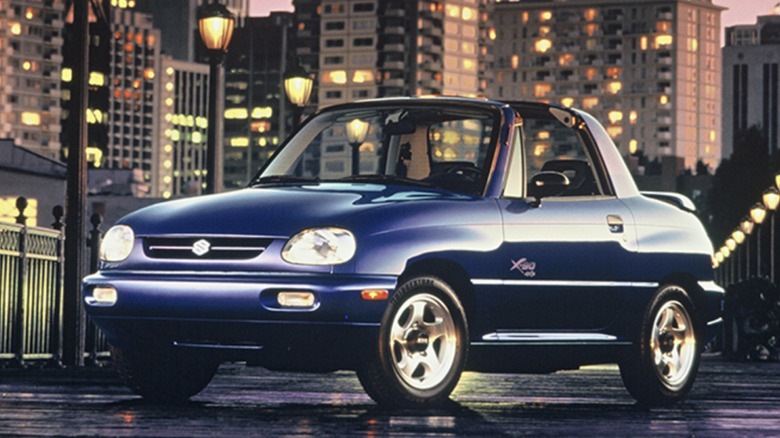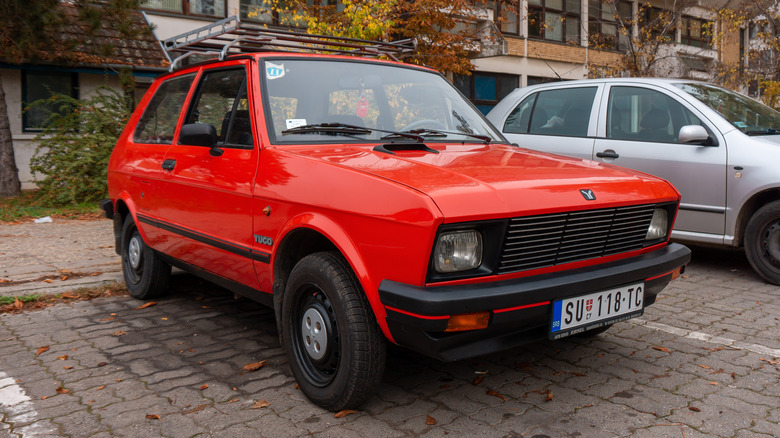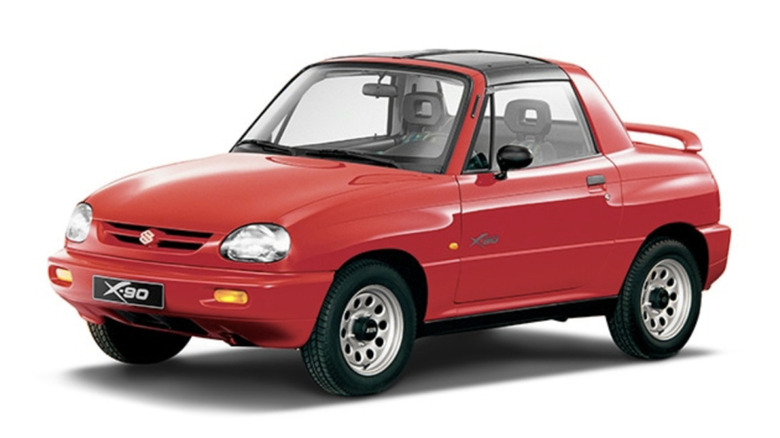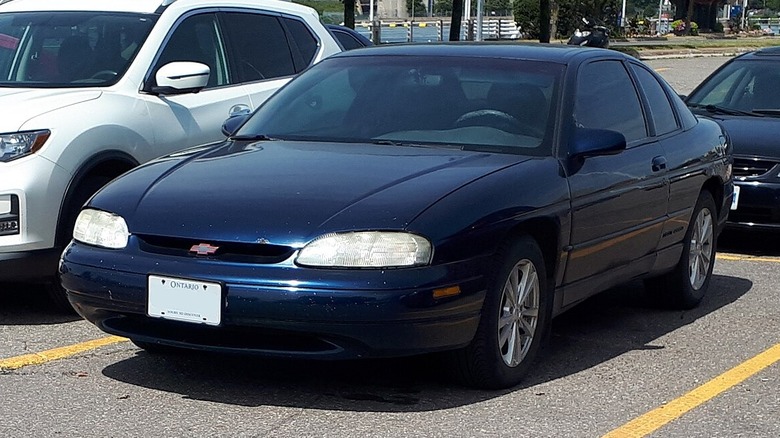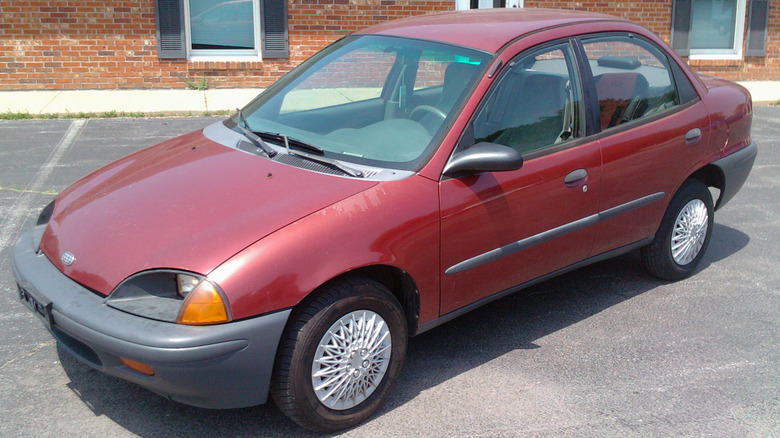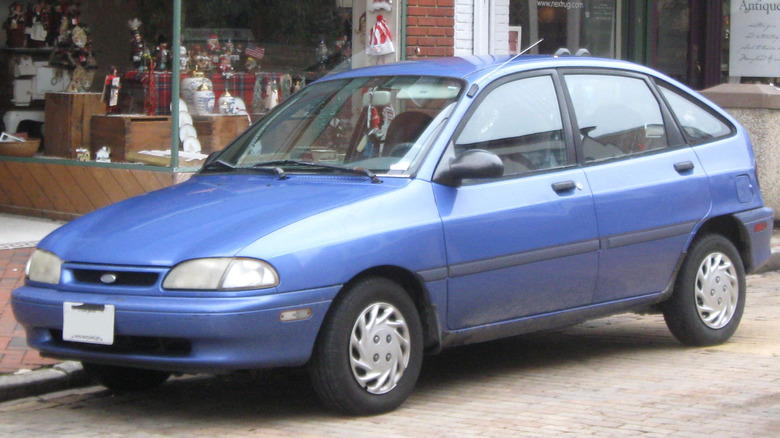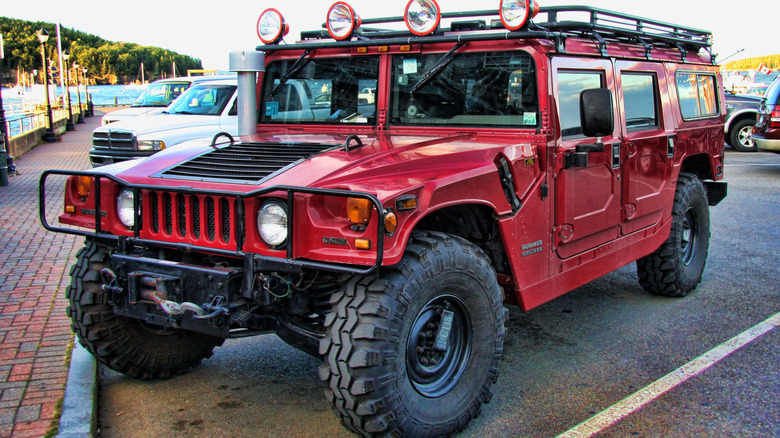6 Of The Worst Cars Built In The 1990s
If the success of stylized, era-correct car shows like Radwood are any indication, there were some seriously cool cars built in the 1990s. Lots of Great Japanese cars (some only available overseas, some available here in the U.S.) bucked horsepower trends and swapped big numbers for big engagement. Some American cars were experimental in their styling and in their execution, but they still registered as relatively cool — even if those '90s cars have been forgotten by history. But despite all those cool models existing, the 1990s also had some real stinkers.
Several automobiles from the 1990s lacked power, capability, and styling. Just like in any other decade of auto manufacturing, some automakers shot for the moon, only to miss wildly and create vehicles that were just plain unpopular. Some concepts were introduced that never caught hold, and other entire car companies were introduced and then lost to the history books in just a few short years. In fact, some of the worst cars ever built were sold in the 1990s. Let's look back on the decade with a critical eye and find some of its worst cars — even if it's painful to our nostalgic sensibilities.
Anything with a Yugo badge really struggled
Having had the opportunity (or misfortune, depending on how you look at it) to personally drive a Yugo GVL on multiple occasions, I can say with absolute certainty that you'll want to avoid anything with a Yugo badge. Buying a bus pass would be a much better way of getting around. Even a small bicycle would be preferable in most scenarios, and it would likely be faster, too. Widely panned as the worst car ever sold in America, Yugos were built in the former nation of Yugoslavia and exported to the United States. Yugos were built and sent to the U.S. from the mid 1980s until 1992, when the Yugo America company eventually went bankrupt. With all the problems surrounding the Yugo, it's not hard to tell why it went belly up.
The Yugo was cheap for its day, priced around $4,000 when new, so sales went well initially. But owners quickly discovered how lethargically slow it was, with just 55 horsepower on tap. During the short period of time Yugos were on sale in the U.S., they were plagued with issues like poor crash test performance, spark plugs that couldn't handle American fuel, and insanely short maintenance schedules (like a timing belt that needed to be replaced every 30,000 miles). It's a cult-classic today thanks to its ironic levels of awfulness, but the Yugo, by any objective standard, was a truly bad car.
The mish-mashed Suzuki X-90 made no sense
Just because a car is quirky doesn't mean it's automatically good. Lots of cars from the 1990s have cult followings that relate to their strange features or weird design qualities, but it's important to remember that those things don't inherently make a car good. A strong example of that point is the Suzuki X-90. The X-90 was a tiny body-on-frame, two-seat, two-door vehicle with a T-top. It's like someone played a car-version of mad libs and got things all mixed up.
Building a convertible with off-roading in mind compromises both missions –- just ask the folks at Jeep how hard it is to keep things quiet and climate-controlled inside the Wrangler. So, with all its mixed-and-matched purposes, the X-90 looked strange and drove strange. According to a Car and Driver test of the X-90 from 1996, the car had a stiff ride, an underpowered engine (it had to make due with just 95 horsepower), and just two seats that made it impractical for most buyers. It was roasted by critics when it was released, and Top Gear Magazine named it one of the worst cars of the last 20 years in the U.S. in 2013. After just three years in production, Suzuki stopped making the X-90.
The Chevrolet Monte Carlo could've been so much better
We know that Chevy was making all sorts of iconic cars back in the 1990s. The Corvette, the Camaro, and even the Impala SS were all worthy of praise — engaging to drive, powerful by the standards of the day, and stylish too. The mid-90s Monte Carlo, however, didn't meet those same standards. The Monte Carlo nameplate was originally launched in the early 1970s, with a 350 cubic-inch V8 under the hood and lots of luxurious touches on the inside. Performance options like the Monte Carlo SS with its 454 big block engine certainly helped raise its status in the early days. The Monte Carlo of the mid 1990s, however, was a different beast.
Powered by a few different (and mostly underwhelming) V6 engines and connected to a four-speed automatic transmission, the Monte Carlo of the '90s wasn't fast, nor was it very entertaining to drive. It was built on the same platform as the pedestrian Chevy Lumina of the day, and it came exclusively with front-wheel drive. Not exactly a recipe for a muscle car revival. Imagine how much better received the Monte Carlo could've been if it used V8 power, rear-wheel drive, and came with an available V8. Sourcing one from the Impala or Camaro might have even been possible.
The Geo Metro was small but a big disappointment
Small, ugly, and vastly underpowered, the Geo Metro didn't have much going for it. Sold at Chevy dealerships, Geo models were rebadged versions of other brands' cars –- cars that were already underwhelming like the Suzuki Sidekick and the Isuzu Impulse. Sure, there were versions of the Metro that had impressive fuel economy estimates (the Metro XFI was rated as high as 47 mpg combined), but paying a little less at the pump came at a big expense.
Like the previously-mentioned Yugo, the Metro had an anemic engine that put out just 55 horsepower. That meant everyday driving tasks like freeway merges were terrifying, and passing maneuvers were pretty much out of the question. Driving dynamics were sloppy at best, with poor steering, underwhelming brakes, and a loud cabin, especially under acceleration. Safety wasn't a top concern for the Metro either. Early models were missing passenger-side airbags and even anti-lock brakes were optional. Eventually, after less than a decade of selling cars, Geo was discontinued.
The Ford Aspire was totally underwhelming
Ford has made some pretty excellent cars over the years, including some small cars with real performance bonafides. Hatchbacks like the Fiesta ST and the Focus ST come to mind, along with higher-performance versions like the rally-inspired Focus RS. Those are cars we'd happily tuck into our garages at night. The Ford Aspire, however, wasn't anything like those hot hatches.
Similar in size to the Geo Metro, the Ford Aspire was technically built by Kia and powered by a small 1.3-liter four-cylinder engine that produced only 64 hp –- just 9 more ponies than the Metro. But while the Metro was pushing nearly 50 mpg, the highest rating that the Aspire could muster was an EPA rating of just 34 mpg combined. And it's not like the Aspire was exactly peppy; Ford sales staff often referred to it as the "Expire," which was a reference to its poor, wheezy acceleration.
On top of lacking speed or refinement, the Aspire was also one of the slowest cars of its era, taking 12.7 seconds to accelerate to 60 miles per hour. To put that into perspective, even the slowest of modern economy cars are in the single digits these days. The Aspire was meant to replace the Festiva, a popular car in Ford's lineup, but instead it flopped. Ford pulled it from the lineup after just three years.
The Hummer H1 was big and bad
The Hummers that are being sold on lots today are big and brutish, much like their forbears. They may be powered by electricity, but the current Hummer EV is the least efficient electric-only vehicle you can buy –- at least according to the EPA's numbers. The current GMC Hummer EV gobbles up 72 kWh of energy per every 100 miles driven. Compare that to something like the Hyundai Ioniq 6, which is efficient enough in some trims to use just 24 kWh of energy per 100 miles driven (a third of the Hummer's consumption), and you'll get some sense of just how power-thirsty the Hummer EV is. That's nothing new for the big bruiser, though.
Early Hummers, like the H1 consumers could buy in the 1990s, were just as bad at the pump. Reviews cited bad braking, poor ride quality, bad interior quality, and single-digit fuel economy as just some of the drawbacks. Built originally as a military vehicle, versions of the Hummer were made available to the public in the early 1990s. Back then, they were built by AM General, right alongside the military models, and there were basically zero considerations for comfort. GM eventually took over the Hummer's production, but not before many civilians got to experience just how bad it was. The H1's off-road capability and toughness was never an issue, though, so at least it had that going for it.
